Children in Crystal Country are going missing. A group of teenagers known as the Pizza & Investigation gang must find a way to solve the mystery of the Demon Puppet-Mistress. However, these teenagers are in the 1980s. Four decades later, you must help them across time in order to finally break the curse.
What Is Tales of Evil?
Tales of Evil is a cooperative exploration and mystery game for 1-6 players, ages 13 and up, and takes about 60 minutes to play a chapter. It’s currently available for sale on Amazon for around $63. Tales of Evil was designed by Antonio Ferrara and published by Escape Studios, with illustrations by Sara Staffelli, Letizia Sacchi, Virginia Chiabotti, and Giorgia Lanza.
Tales of Evil Components
- 1 Rulebook
- 1 Story Book
- 1 Event Book
- 5 Dice
- 6 Double-sided Game boards
- 7 Investigator standees with bases
- 7 Investigator miniatures
- 1 Aberration miniature
- 7 Investigator boards
- 1 Events board
- 1 Hourglass
- 216 Cards
- 1 walkie-talkie token
- 156 other game tokens

In addition to standees, the game also includes miniatures of the seven investigators as well as a scary jack-in-the-box to represent the current aberration the investigators face. Either can be used for gameplay as they represent the location of the investigators on the game boards.
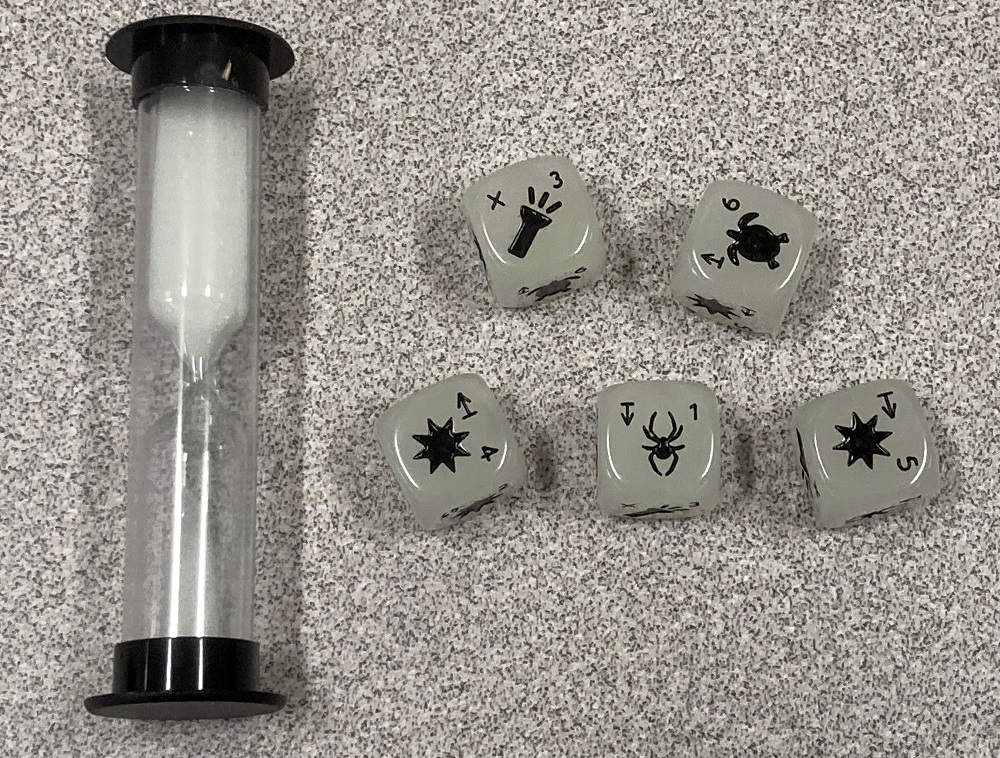
The five dice are different than your typical dice. Instead of pips representing numbers, each die has symbols. Three of the sides have a starburst symbol which counts as a hit. There is a spider which ‘eats’ the results of one of your dice. The turtle can cancel a spider or may have another use depending on the situation. Finally, the flashlight symbol is used by some items with varying effects, though they often require you to spend one of your batteries to activate the effect. In addition to the symbols, each face has a number from 1 to 6 as well as an arrow or directional symbol that are used during the story. The game also includes a 60 second ‘hourglass’ for timing activities for the Fusion System.

Each player gets an investigator board for each investigator they are playing. This keeps track of everything for that investigator. At the top, the status cards are placed in order from 1 to 4. Each status card lists the characteristics for that investigator as well as their starting body, mind, and fear tokens which are similar to health. As an investigator takes damage, the tokens representing either mind or body are removed as directed by the game. If not enough tokens of that attribute remain, then fear tokens are removed. Once all fear tokens are gone, the top status card is removed and tokens are reset for the new status card’s values. When the last fear token is removed from the last status card, then the investigator is out of action for the rest of the game. Status cards also are a way of making the game more difficult. Use all four status cards for an easier game, cards 2-4 for a normal game, and only cards 3 and 4 for a hard game. In addition to keeping track of status, the investigator board also serves to show what the investigator is carrying or wearing by placing item cards on the designated spots.
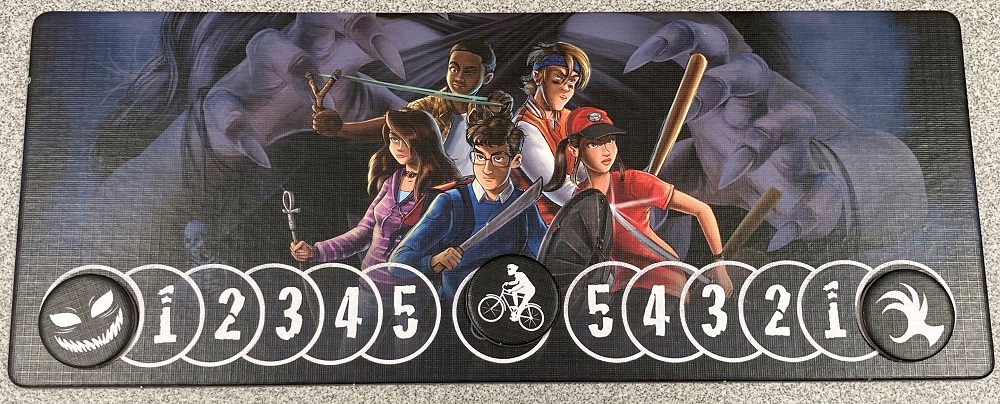
The events board is setup as directed by the story book. The group token (investigator on a bicycle) shows the limits of what the investigators can take before the game is lost. The terror token (scary face) shows the level of terror experienced while the panic token (claw) indicates the progress of a possible aberration. If the panic or terror tokens ever reach the group token, it is game over.
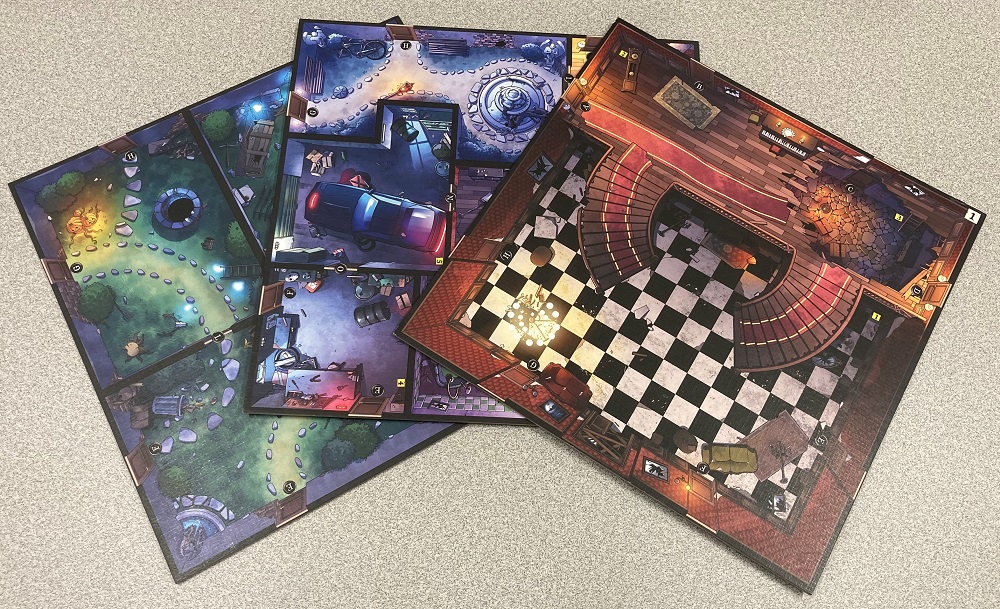
Tales of Evil features six double-sided game boards that represent parts of the haunted house and the surrounding areas. Most boards are divided into rooms or areas where the investigators explore to try to complete their main objective. The boards can be placed together to connect rooms as directed by the story book.
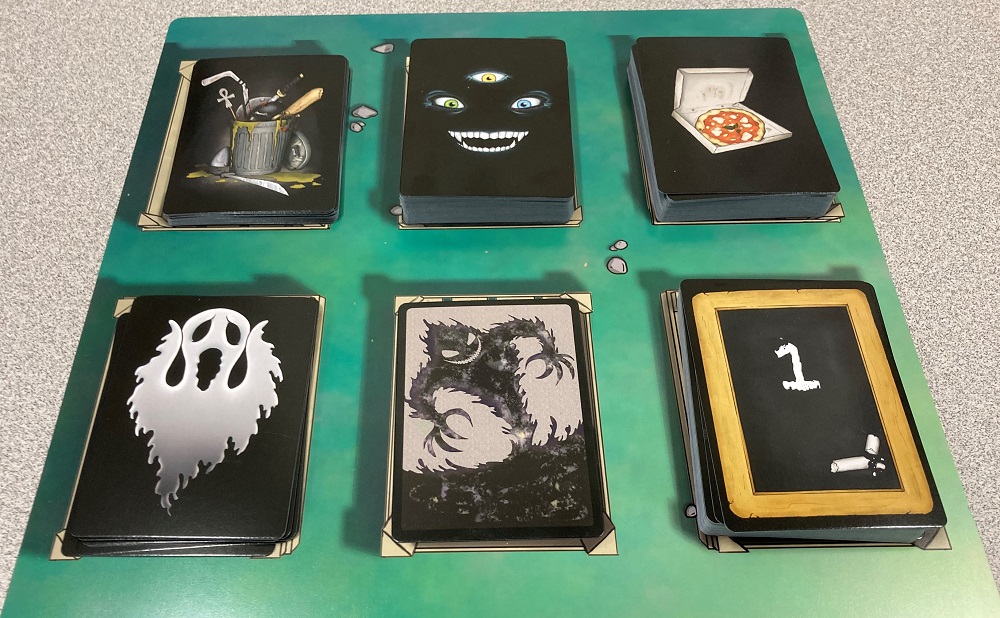
There are several types of cards included in the game. Search cards (pizza) represent objects the investigators find in the game and all have a test for a reward or penalty. Event cards (eyes and mouth) are drawn when instructed by the game and can be events or creatures. Equipment cards are items which can be purchased in-between adventures. Trauma cards (ghost) are debilitating cards drawn when instructed. The numbered special cards are also used when called for by the story book or other cards. Daphne can use ritual cards if she is carrying a magical object. Finally each investigator has three action cards which can be played when it is not their turn to help another investigator.
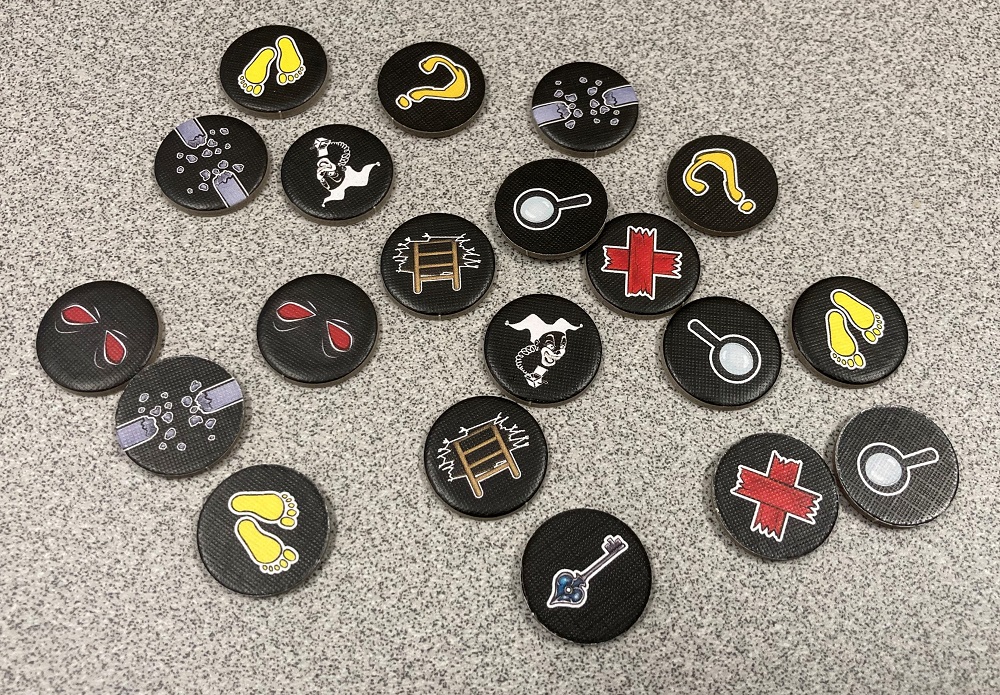
In addition to the tokens already mentioned for status and the events board, the game includes other tokens which are placed on the game boards to show opportunities for searching, clues, secret passages, a barred passage, and more. They are placed as instructed by the game.
How to Play Tales of Evil
While the game comes with a rulebook, it is more of reference and description of the components. Instead, the rules are explained on a ‘need-to-know’ basis as you progress through the story. While you can read the rulebook, don’t read the story book or look at the cards until instructed to do so by the game.
The Goal
The game is divided into a tutorial and six chapters. The goal of the tutorial is to teach players the rules and how the game system works. Each of the six chapters has its own objective that must be completed for ‘mission accomplished’.
Setup
Set up is fairly simple for this game. Take the investigator boards and read the backs to learn the story for each of the characters which are known as investigators. Each player (called Braves in the game) then picks one investigator to play as and collects the matching standee or miniature. Players can play as more than one investigator if they choose; however, there is a maximum of 6 investigators for the game.
Turn over the investigator board and place the status cards in the center of the board, based on the difficulty level. Collect body, mind, and fear tokens equal to the value shown on the top status card. Next collect 3 battery tokens as well as the 3 action cards related to the the investigators. The player whose birthday is next takes the walkie-talkie token. Set aside the equipment and special cards. Shuffle the Search, Event, and Trauma decks of cards separately and place them face down on the table. Finally take the chapter card for the chapter you are playing and follow the instructions. If playing the Prologue which is the tutorial, read paragraph 1 in the story book to get started.
Gameplay
The story book is what guides the game. Pick one player to be the reader, usually a player with good reading skills. It is suggested that the reader have a bookmark to keep track of where they are in the story book since it reads like a ‘choose-your-own-adventure’ book by sending you different numbered paragraphs depending on the choices the players make or the results of their actions. The player with the walkie-talkie token is the active player. They draw cards and read them as instructed. They make decisions unless the game calls for the players to decide together.
The active player can perform a variety of different actions depending on the circumstance. After a paragraph has been read, there may be different choices to be made. The active player makes the choice unless a group choice is called for. Then the group votes on the decision. When a new area has been revealed, a player may choose to move to that new room or area. Unless otherwise specified, all of the investigators move together as a group. There is safety in numbers. Occasionally, an opening is too small for all of the investigators to move through it. In that case, only those who can fit will advance to the next space. Often when entering a new room, search tokens will be placed. Players can use their action to remove the search token, which looks like a pizza, and draw a search card. These always require a characteristics test with either a reward or penalty depending on the results. Most search cards are items the player who searched can keep whether they passed or failed the test. Other actions include attacking and/or defending against an aberration, using an item, preforming a ritual, organizing or exchanging items between investigators, and if at the Recovery Shop, buying and selling items. After a player performs an action, the walkie-talkie token is passed to the next player who then can take an action. With the reading of the paragraphs, it can sometimes be confusing at first when to pass the walkie-talkie. Just remember whenever an action takes place, even if it is a choice, the active player changes.

When players must attack or defend, they roll a number of dice based on either their attack or defense value on their status current status card. Be sure to add any bonuses from items the investigator is carrying. When attacking, each hit that is not cancelled is applied as damage to the aberration. When defending, the investigator is hit with a certain amount of damage. Roll the number of dice equal to the defense value and any bonuses. Each hit result then blocks one of the points of damage. Investigators can take either body or mind damage depending on the attack.
At times, investigators must make a characteristic test as directed by the story book or a card. Check the investigators value for that trait and roll that many dice. You need a number of hits equal to the test number after spiders and turtle results have been resolved in order to pass the test.
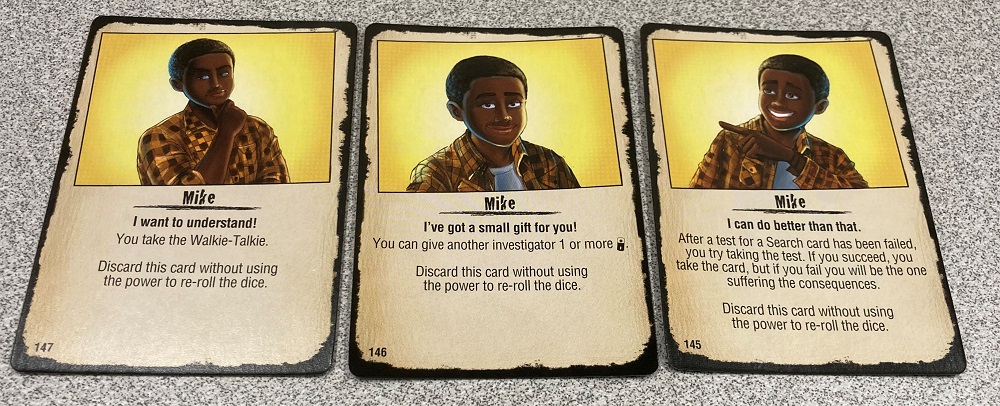
An interesting part of the game is what is called the Fusion System. While the players are controlling the investigators in the game, they are also participating in real-life. For example, a paragraph or card might ask if a player in the group has a mirror on them. Or they may have to use the 60 second hourglass to time whether the group can find an object just as a spoon. These real objects have an effect on the gameplay. So players never know when they have to become an active participant in the mystery. You may even have to send an email or call a number.
Game End
The game is divided into chapters. Each chapter can end in three different ways. The story book will let you know your results. If you complete the main objective, you get a Mission Accomplished result and can continue on to the next chapter. You can also get a Mission (Almost) Complete result. You have finished the chapter, but did not complete the main objective. You can then decide to either play the chapter again or continue on to the next chapter. When the Terror or Panic Tokens on the events board reach the group token, the mission is a failure and you must attempt the chapter again.
Why You Should Play Tales of Evil
Tales of Evil is unlike any other game I have played. In the past, I have experienced games with a story book or other choose-your-own-adventure type feel. However, Tales of Evil takes this to the next level. The rule book is basically just an explanation of the contents of the game and some basic mechanics. In fact, the designer even states that he believes the gaming experience should be lived rather than studied and thus the rules, including the setup for each chapter, are included in the storybook. This makes it very easy to get into the game because you learn the rules as you play. The tutorial level literally walks you through everything you need to know whenever there is an attack, characteristic test, or other event. The downside of this is that the first game or two can take longer as the players are learning the game together rather than have one player read the rules ahead of time and teach the players.
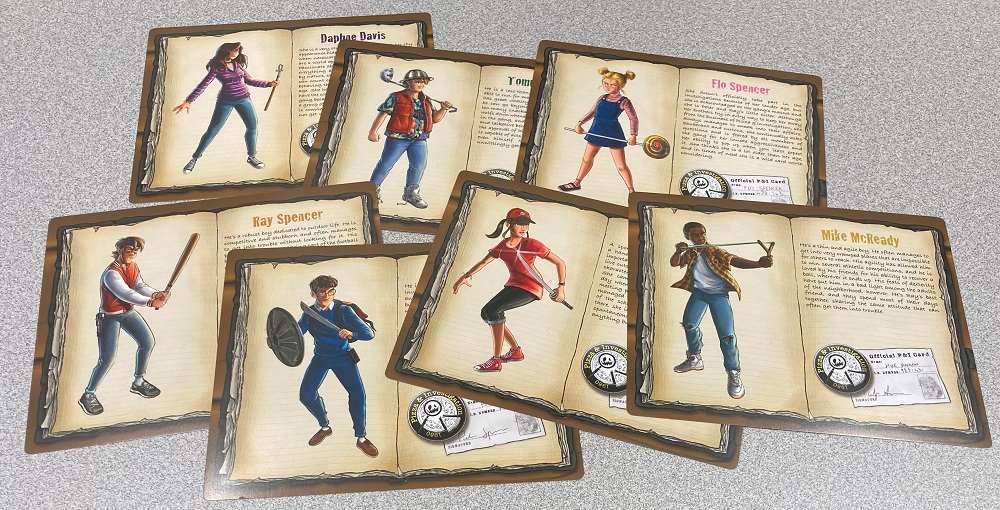
The story of the game is incredible. Without giving away the story, the investigators are in the 1980s and part of a curse that you must help them break while the players are in the current time and essentially helping them through the walkie-talkie. Adding the use of email, websites, phone numbers, and such in the real world add a new dimension to the way the story unfolds. I was really impressed with the Fusion System in which players have to perform actions that have an impact on the investigators in the game. All of these elements really help players feel like they are living the game rather than just playing it.
I am also impressed by the game mechanics. While rolling for characteristic tests is found in many RPG games, the dice with their unique symbols which can cancel other results add some additional challenge. However, through the use of battery tokens, (each investigator usually begins with 3) you can activate special abilities depending on the items you have to cancel or change dice results. At times, a random investigator must be chosen to respond to an event. The game includes 7 matchstick tokens of various lengths. The active player holds them and then players pick one each. The player who draws the shortest matchstick is the one chosen. The game even has a great way to save your progress between chapters. The game box has an insert with six slots where each investigator can store their cards including the items they have found or purchased so they are ready for the next chapter.
Tales of Evil is definitely a work of love for the designer, Antonio Ferrara. While many of the mechanics are familiar, the way they are incorporated together makes the game incredible. As we were playing it, there was a feel of the unexpected looming over us. We never knew when one of us would have to jump up and find an item in the house to bring back to the table or if we would have to pull out a cellphone and send an email and wait for a response. The game also keeps all players engaged. Even if it is not your turn, you must follow the story and be ready to help fight off a creature or help the active player escape from danger. I highly recommend Tales of Evil for those who enjoy a cooperative experience which combines story and a unique combination of game mechanics which will last for several gaming sessions.
Click here to see all our tabletop game reviews.
![]() To subscribe to GeekDad’s tabletop gaming coverage, please copy this link and add it to your RSS reader.
To subscribe to GeekDad’s tabletop gaming coverage, please copy this link and add it to your RSS reader.
Disclosure: GeekDad received a copy of this game for review purposes.





